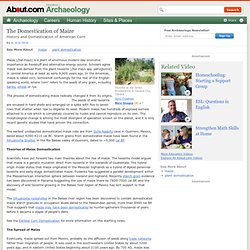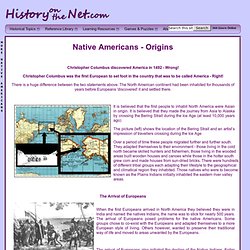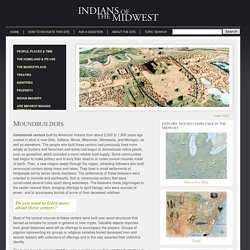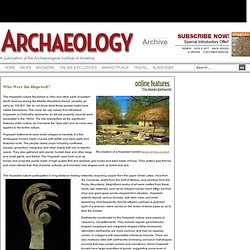

The First American Civilization built by Native Americans! Native american shamanic music mix to meditate and relax - by Morpheus. War of the American Indians : Documentary on the History of the Iroquois. Cahokia - City of the Sun. Native America before European Colonization. The First American Civilization built by Native Americans! Hopewell Culture. Around 200 B.C, the beginning of the Middle Woodland period, a new Native American culture developed that spread throughout the Midwest (then known as the Eastern Woodland) identified as Hopewell.

There was not a specific tribe that can accredited with the establishment of the Hopewell principles, instead Hopewell is more of a culture and way of life that was experienced throughout multiple areas spanning from places including: Nebraska to Mississippi, Indiana to Minnesota, Virginia to the epicenter area of Ohio. Specifically in Ohio the culture was heavily influential in the Southeastern region that consists of the Ohio Valley, the Scioto Valley, and the Miami Valley. Typically Hopewell tribes resided near major waterways and abundantly resourced rivers to support their agricultural lifestyle and expand the complex trading system they were cultivating.
The Hopewell communities are also defined by their intricate trading system. See Also References Lepper, Bradley T. Who were the Mound Builders? The First American Civilization built by Native Americans! Maize - History and Domestication of American Corn. Maize (Zea mays) is a plant of enormous modern-day economic importance as foodstuff and alternative energy source.

Scholars agree maize was derived from the plant teosinte (Zea mays spp. parviglumis) in central America at least as early 9,000 years ago. In the Americas, maize is called corn, somewhat confusingly for the rest of the English-speaking world, where 'corn' refers to the seeds of any grain, including barley, wheat or rye. The process of domesticating maize radically changed it from its origins. The seeds of wild teosinte are encased in hard shells and arranged on a spike with five to seven rows that shatter when ripe to disperse its seed. Modern maize has hundreds of exposed kernels attached to a cob which is completely covered by husks and cannot reproduce on its own.
The earliest undisputed domesticated maize cobs are from Guila Naquitz cave in Guerrero, Mexico, dated about 4280-4210 cal BC. United States History Map . Indians. Native Americans - Origins. Christopher Columbus discovered America in 1492 - Wrong!

Christopher Columbus was the first European to set foot in the country that was to be called America - Right! There is a huge difference between the two statements above. The North American continent had been inhabited for thousands of years before Europeans 'discovered' it and settled there.
It is believed that the first people to inhabit North America were Asian in origin. Native American History - Pre-European Period. Everything was water except a very small piece of ground.

Who Were The First Americans? Stefan Lovgrenfor National Geographic News September 3, 2003 A study of skulls excavated from the tip of Baja California in Mexico suggests that the first Americans may not have been the ancestors of today's Amerindians, but another people who came from Southeast Asia and the southern Pacific area.

The question of who colonized the Americas, and when, has long been hotly debated. Traditionally, Native Americans are believed to have descended from northeast Asia, arriving over a land bridge between Siberia and Alaska some 12,000 years ago and then migrating across North and South America. But recent research, including the Baja California study, indicates that the initial settlement of the continent was instead driven by Southeast Asians who occupied Australia 60,000 years ago and then expanded into the Americas about 13,500 years ago, prior to Mongoloid people arriving from northeast Asia.
Challenging Clovis But more recent discoveries challenge the Clovis story. Native American History. They are the only Americans that can claim they were here first!

This homeschool sub-curriculum consists of 9 lessons and explores how different physical environments shaped Native American cultures. We recommend that this sub-curriculum in Native American history be taught one lesson per week in the order below. Lessons. Copy of Native Americans by Sabine Yamamura on Prezi. THE AMERICAN INDIANS. The Moundbuilders.
Hopewell Culture. Cahokia - Mound Builders - Echoes Of The Past. Indians of the Midwest. Ceremonial centers built by American Indians from about 2,200 to 1,600 years ago existed in what is now Ohio, Indiana, Illinois, Wisconsin, Minnesota, and Michigan, as well as elsewhere.

The people who built these centers had previously lived more simply as hunters and fisherman and some had begun to domesticate native plants, such as goosefoot, which provided a more reliable food supply. Some communities had begun to make pottery and to bury their dead in or under conical mounds made of earth. Then, a new religion swept through the region, attracting followers who built ceremonial centers along rivers and lakes. They lived in small settlements of kinspeople led by senior family members. The settlements of these believers were oriented to mounds and earthworks, that is, ceremonial centers that were constructed several miles apart along waterways. [X] Close The religious leaders associated with these ceremonial centers conducted several kinds of ceremonies there. 4:30 mi.
Who Were the Hopewell? Re-creation of a Hopewell hamlet (www.cerhas.uc.edu) The Hopewell culture flourished in Ohio and other parts of eastern North America during the Middle Woodland Period, possibly as early as 100 B.C.

We do not know what these people might have called themselves. The name we use comes from Mordecai Hopewell, a Chillicothe landowner on whose property mounds were excavated in the 1800s.